The Relationship between Emotional Perception and High-Density Built Environment Based on Social Media Data: Evidence from Spatial Analyses in Wuhan
Abstract
1. Introduction
2. Materials and Methods
2.1. High-Density Built Environment Indicators and Hypothesis
| Indicator | Calculation Method | Formula | Reference | |
|---|---|---|---|---|
| Primary Indicator | Secondary Indicator | |||
| Urban Form | FSI (Floor Space Index) | Ratio of gross floor area to site area | Berghauser, P. (2004) [49] | |
| is the sum of all floor areas in the block, and is the area of the block. | ||||
| GSI (Ground Space Index) | Ratio of building base area to site area | |||
| is a building in the block, is the building base area of the th building, and is the area of the block. | ||||
| OSR (Open Space Ratio) | Ratio of open space area to site area | |||
| is a building in the block, is the building base area of the th building, and is the area of the block. | ||||
| BAL (Building Average Layer) | Average Layer of buildings in the block | |||
| is a building in the block, is the number of layers in the th building, and is the number of buildings in the block. | ||||
| Green Environment | GSR (Green Space Ratio) | Ratio of green space area to site area in the block | - | |
| is the sum of the areas of the various types of green spaces in the blocks, and is the area of the block. | ||||
| NDVI (Normalized Difference Vegetation Index) | Calculated based on the reflectance of light in the visible and near-infrared portions of the electromagnetic spectrum. | Jin, K. (2020) [54] | ||
| is the reflectance in the near-infrared spectrum, and is the reflectance in the red spectrum. | ||||
| WI (Water Index) | Minimum distance from the block to the surrounding water | Wang, J. (2016) [53] | ||
| takes the value of 3000 m search radius, and is the closest distance to the water. | ||||
| Urban Function | PFM (POI Functional Mixture) | Ratio for each type of POI function point | Xue, B. (2018) [55] | |
| is the number of POI types in the block, and is the ratio of the number of types of th POIs in the block to the total number. | ||||
| PFD (POI Functional Density) | Kernel density at each POI functional point | Miaoyi, L.I. (2018) [56] | ||
| is the POI data point density fraction (points/km2) for a facility point within a block, is the sum of the values of the POI points for that facility point within the block, and is the area of the block (km2). | ||||
| Transportation | RND (Road Network Density) | Ratio of road length to site area in a block | Jenelius, E. (2009) [57] | |
| is the sum of the lengths of all types of roads in the block, and is the area of the block. | ||||
| SSI (Space Syntax Integration) | The ratio of the generalized distance to the generalized distance from the line segment to all other line segments | Hillier and Iida’s (2005) [59] | ||
| is the shortest path between line i and line k. r = 500 m | ||||
| SSC (Space Syntax Choice) | Ratio of the number of times the shortest path crosses an axis to the shortest path | Xia, X. (2013) [60] | ||
| is the shortest path between line segment and line segment , and is the shortest path between line segment and line segment that contains line segment . r = 500 m | ||||
| PD (Population Density) | Ratio of residential population in a block-to-block area | Burton, E (2002) [61] Shen, Y. (2019) [62] | ||
| is total population in the block, and is the area of the block (km2). | ||||
2.2. Study Area
2.3. Data Resources
2.3.1. Built Environment Data
2.3.2. Emotional Perception Data
2.4. Methods
2.4.1. Research Framework
2.4.2. Emotional Perception Classification
2.4.3. Spatial Autocorrelation Analysis
2.4.4. Multi-Scale Geographically Weighted Regression (MGWR) Model
3. Results
3.1. Overview of Data Quantification
3.1.1. High-Density Built Environment
3.1.2. Spatial Characterization of Emotional Perception
3.2. Regression Model Results
3.2.1. Spatial Clustering Features of Emotional Perception
3.2.2. Independent Variable Screening
3.2.3. Regression Coefficients and Spatial Distribution of Explanatory Variables of the MGWR Model
- (1)
- MGWR Regression Model Results
- (2)
- Descriptive Statistics of Standardized Regression Coefficients
- (3)
- Spatial Heterogeneity of Regression Coefficients
4. Discussion
4.1. Interpretation of the Effects of Spatial Heterogeneity of Variables
4.1.1. Urban Form
4.1.2. Green Environment
4.1.3. Urban Function
4.1.4. Transportation
4.1.5. Population Density
4.2. Limitation of Social Media Data
5. Conclusions
- Increasing public open spaces in high-density residential areas to provide ample outdoor activity areas and simultaneously adding vegetation can help regulate micro-climates, ultimately enhancing feelings of comfort.
- Planning mixed-use developments around transportation nodes and scenic areas, as well as strengthening the layout of public service facilities to enhance functional diversity.
- Increasing road network density in the peripheries of central urban areas to improve accessibility, while restricting vehicle traffic in central urban areas.
- Controlling construction scale and limiting building height in old towns and surrounding areas, preserving sufficient view corridors.
Author Contributions
Funding
Data Availability Statement
Conflicts of Interest
References
- Izard, C.E. Human Emotions; Springer Science & Business Media: Berlin, Germany, 2013; ISBN 978-1-4899-2209-0. [Google Scholar]
- Wierzbicka, A. Human Emotions: Universal or Culture-Specific? Am. Anthropol. 1986, 88, 584–594. [Google Scholar] [CrossRef]
- Salesses, P.; Schechtner, K.; Hidalgo, C.A. The Collaborative Image of The City: Mapping the Inequality of Urban Perception. PLoS ONE 2013, 8, e68400. [Google Scholar] [CrossRef] [PubMed]
- Golder, S.A.; Macy, M.W. Diurnal and Seasonal Mood Vary with Work, Sleep, and Daylength Across Diverse Cultures. Science 2011, 333, 1878–1881. [Google Scholar] [CrossRef] [PubMed]
- Tuan, Y.-F. Space and Place: The Perspective of Experience; University of Minnesota Press: Minneapolis, MN, USA, 1977; pp. 1–7. [Google Scholar]
- Milton, K. Loving Nature: Towards an Ecology of Emotion; Routledge: London, UK, 2002. [Google Scholar]
- Hochschild, A.R. The Commercialization of Intimate Life; University of California Press: Berkeley, CA, USA, 2003. [Google Scholar]
- Chodorow, N.J. The Power of Feeling; Yale University Press: New Haven, CT, USA, 1999. [Google Scholar]
- Nussbaum, M.C. Upheavals of Thought: The Intelligence of Emotions; Cambridge University Press: Cambridge, UK, 2003. [Google Scholar]
- Marcus, G.E. The Sentimental Citizen: Emotion in Democratic Politics; Pennsylvania State University Press: University Park, PA, USA, 2002. [Google Scholar]
- Ahmed, S. The Cultural Politics of Emotion; Edinburgh University Press, Routledge: New York, NY, USA, 2004. [Google Scholar]
- Davidson, J.; Milligan, C. Embodying Emotion Sensing Space: Introducing Emotional Geographies. Soc. Cult. Geogr. 2004, 5, 523–532. [Google Scholar] [CrossRef]
- Lynch, K. The Image of the City; MIT Press: Boston, MA, USA, 1960. [Google Scholar]
- Norberg-Schulz, C. Genius Loci: Towards a Phenomenology of Architecture (1979). Hist. Cities Issues Urban Conserv. 2019, 8, 31. [Google Scholar]
- Gerson, K.; Stueve, A.; Fischer, C.S. Attachment to place. In Networks and Places: Social Relations in the Urban Setting; The Free Press: New York, NY, USA, 1977; pp. 139–161. [Google Scholar]
- Proshansky, H.M. The City and Self-Identity. Environ. Behav. 1978, 10, 147–169. [Google Scholar] [CrossRef]
- Jia, J.; Zhen, F.; Xi, G. A Review on Emotional Geography: Its Progress and Enlightenment. World Reg. Stud. 2016, 25, 123–136. [Google Scholar]
- Zhu, H.; Gao, Q. Review on “Emotional Turn” and Emotional Geographies in Recent Western Geography. Geogr. Res. 2015, 34, 1394–1406. [Google Scholar]
- Plunz, R.A.; Zhou, Y.; Carrasco Vintimilla, M.I.; Mckeown, K.; Yu, T.; Uguccioni, L.; Sutto, M.P. Twitter Sentiment in New York City Parks as Measure of Well-Being. Landsc. Urban Plan. 2019, 189, 235–246. [Google Scholar] [CrossRef]
- Zheng, Y.; Jizhen, L.; Bingrong, L.; Min, C. Perception and Evaluation of Cityscape Characteristics Using Semantic Analysis on Microblog in the Main Urban Area of Chongqing Municipality. Prog. Geogr. 2017, 36, 1058–1066. [Google Scholar]
- Shelton, T.; Poorthuis, A.; Zook, M. Social Media and the City: Rethinking Urban Socio-Spatial Inequality Using User-Generated Geographic Information. Landsc. Urban Plan. 2015, 142, 198–211. [Google Scholar] [CrossRef]
- UN-Habitat. International Guidelines on Urban and Territorial Planning; United Nations Human Settlements Programme: Nairobi, Kenya, 2015. [Google Scholar]
- Hu, L. A Study on Diagrammatic Assessment Approaches to the Sustainable Morphology of Urban Density. Master’s Thesis, University of Hong Kong, Hong Kong, China, 2011. [Google Scholar]
- Resch, E.; Bohne, R.A.; Kvamsdal, T.; Lohne, J. Impact of Urban Density and Building Height on Energy Use in Cities. Energy Procedia 2016, 96, 800–814. [Google Scholar] [CrossRef]
- Bardhan, R.; Kurisu, K.; Hanaki, K. Does Compact Urban Forms Relate to Good Quality of Life in High Density Cities of India? Case of Kolkata. Cities 2015, 48, 55–65. [Google Scholar] [CrossRef]
- Yang, J.; An, R.; Tong, Z.; Liu, Y. Exploring the Relationship between Built Environment and Ventilation Potential in Wuhan, A Multi-Scale Geographically Weighted Regression Analysis. J. Nanjing Norm. Univ. Sci. Ed. 2023, 4, 29–39. [Google Scholar]
- Douglas, E. Examining the Relationship between Urban Density and Sense of Community in the Greater Vancouver Regional District. Cities 2022, 130, 103870. [Google Scholar] [CrossRef]
- Beixiang, S.; Malwin, S.; Junyan, Y. Study on the Quality Improvement of Built Environment in High Density Urban Areas under the Background of Post Smart City Transformation. Int. Urban Plan. 2021, 36, 16–21. [Google Scholar]
- Zhang, Q.; Xu, H.; Huang, Q. A Review of the Interactive between People and the Built Environment. Archit. J. 2016, 2, 118–124. [Google Scholar]
- Shi, B.; Yang, J. Large Scale Spatial Morphology Analysis Method Based on GIS Platform: Take the Height, Density and Intensity of the Metropolitan Central Districts as Example. Urban Plan Int. 2019, 34, 111–117. [Google Scholar] [CrossRef]
- Wang, J. A Research into the Large-Scaled Spatial Forms of Cities Based on Urban Design. Sci. China Ser. E Technol. Sci. 2009, 52, 2486–2496. [Google Scholar] [CrossRef]
- Zhou, A.; Guo, H. Coherence Measure of Spatial Morphology Based on GIS and Space Syntax. Geomat. Spat. Inf. Technol. 2016, 39, 170–172. [Google Scholar]
- Liu, S.; Li, T.; Chen, H.; Zhang, J.; Tian, G.; Cai, D. Research on the Simulati on of NDVI Dynamic Monitoring Based on Temporal GIS. Res. Soil Water Conserv. 2006, 13, 165–166+169. [Google Scholar]
- Zhang, J.; Shi, W.; Xiu, C. Urban Research Using Points of Interest Data in China. Sci. Geogr. Sin. 2021, 41, 140–148. [Google Scholar]
- Fan, L.; Zhang, D. Research on the Influence Mechanism and Spatial Heterogeneity Characteristics of Block Vitality in Beijing: Based on Multi-Scale Geographically Weighted Regression. City Plan. Rev. 2022, 46, 27–37. [Google Scholar]
- Wang, F.; Yan, L.; Xiong, X.; Wu, B. A Study on Tourist Cognition of Urban Memory in Historic Sites: A Case Study of Alley Nanluogu Historic Site in Beijing. Acta Geogr. Sin. 2012, 67, 545–556. [Google Scholar]
- Liang, J.; Jiang, S.; Tao, L. Empirical Research on the Relationship between Spatial-Temporal Behavior and Emotion of Tourists Based on Semantic Analysis of online Travel Blogs and GIS Visualization: A Case of Beijing. Hum. Geogr. 2020, 35, 152–160. [Google Scholar]
- Zhang, F.; Zhou, B.; Liu, L.; Liu, Y.; Fung, H.H.; Lin, H.; Ratti, C. Measuring Human Perceptions of a Large-Scale Urban Region Using Machine Learning. Landsc. Urban Plan. 2018, 180, 148–160. [Google Scholar] [CrossRef]
- Rossetti, T.; Lobel, H.; Rocco, V.; Hurtubia, R. Explaining Subjective Perceptions of Public Spaces as a Function of the Built Environment: A Massive Data Approach. Landsc. Urban Plan. 2019, 181, 169–178. [Google Scholar] [CrossRef]
- Verma, D.; Jana, A.; Ramamritham, K. Machine-Based Understanding of Manually Collected Visual and Auditory Datasets for Urban Perception Studies. Landsc. Urban Plan. 2019, 190, 103604. [Google Scholar] [CrossRef]
- Fan, L.; Zhang, D. Research on Spatial Perception of Urban Image Hotspots under New Social Media: Take the Note Data of Beijing Xiaohongshu as an Example. Urban Dev. Stud. 2022, 29, 1–8. [Google Scholar]
- Cui, L.M.; Qu, L.Y.; He, D. Evaluating Emotional Perception of Spatial Hotspots via Deep Learning: A Case Study of Shanghai. Hum. Geogr. 2021, 36, 121–130. [Google Scholar]
- He, H.; Ding, H.; Sun, R. Spatiotemporal Analysis of Residential Happiness in Urban Functional Zones Based on Social Sensing. Acta Ecol. 2023, 43, 2298–2309. [Google Scholar]
- Wang, B.; Zhen, F.; Zhang, H. The Dynamic Changes of Urban Space-Time Activity and Activity Zoning Based on Check-in Data in Sina Web. Sci. Geogr. Sin. 2015, 35, 151–160. [Google Scholar]
- Wu, Y.; Dong, W.; Zhang, W. Research on Influencing Factors of Built Environment Perception in Neighborhoods: Evidence from Behavioral Experiment. City Plan. Rev. 2022, 46, 99–109. [Google Scholar]
- Figueiredo, M.; Eloy, S.; Marques, S.; Dias, L. Older People Perceptions on the Built Environment: A Scoping Review. Appl. Ergon. 2023, 108, 103951. [Google Scholar] [CrossRef]
- Larkin, A.; Gu, X.; Chen, L.; Hystad, P. Predicting Perceptions of the Built Environment Using GIS, Satellite and Street View Image Approaches. Landsc. Urban Plan. 2021, 216, 104257. [Google Scholar] [CrossRef] [PubMed]
- Ewing, R.; Cervero, R. Travel and the Built Environment. J. Am. Plan. Assoc. 2010, 76, 265–294. [Google Scholar] [CrossRef]
- Berghauser Pont, M.; Haupt, P. Spacemate: The Spatial Logic of Urban Density; Delft University Press Science: Delft, The Netherlands, 2004. [Google Scholar]
- Berghauser Pont, M.; Haupt, P. The Spacemate: Density and the Typomorphology of the Urban Fabric. In Urbanism Laboratory for Cities and Regions: Progress of Research Issues in Urbanism 2007; IOS Press: Amsterdam, The Netherlands, 2007; pp. 11–26. Available online: http://arkitekturforskning.net/na/article/download/167/130 (accessed on 2 October 2023).
- Berghauser Pont, M.; Haupt, P. The Relation between Urban form and Density. Urban Morphol. 2007, 11, 62–65. [Google Scholar] [CrossRef]
- CJJ/T85-2017; Standard for Classification of Urban Green Space. Ministry of Housing and Urban-Rural Development of the People’s Republic of China: Beijing, China, 2017.
- Wang, J.; Zhu, A.; Wang, M. Correlating Physical Forms of Riparian Zones in Urban Parks with Effective Eco-Services Provision of Water Self-Purifi Cation: A Case Study of Shanghai Mengqing Park. Landsc. Archit. 2016, 8, 118–127. [Google Scholar]
- Jin, K.; Wang, F.; Han, J.; Shi, S.; Ding, W. Contribution of Climatic Change and Human Activities to Vegetation NDVI Change over China during 1982–2015. Acta Geogr. Sin. 2020, 75, 961–974. [Google Scholar]
- Xue, B.; Xiao, X.; Li, J. POI-Based Analysis on Retail ’s Spatial Hot Blocks at a City Level: A Case Study of Shenyang, China. Econ. Geogr. 2018, 38, 36–43. [Google Scholar]
- Miaoyi, L.I.; Yan, M.A.; Sun, X.; Wang, J.; Dang, A. Application of Spatial and Temporal Entropy Based on Multi-Source Data for Measuring the Mix Degree of Urban Functions. City Plan. Rev. 2018, 42, 97–103. [Google Scholar]
- Jenelius, E. Network Structure and Travel Patterns: Explaining the Geographical Disparities of Road Network Vulnerability. J. Transp. Geogr. 2009, 17, 234–244. [Google Scholar] [CrossRef]
- Jin, D.; Hillier, B. Spatial Syntax and Urban Planning; Southeast University Press: Nanjing, China, 2007. [Google Scholar]
- Hillier, B.; Iida, S. Network and Psychological Effects in Urban Movement. In Spatial Information Theory; Cohn, A.G., Mark, D.M., Eds.; Lecture Notes in Computer Science; Springer Berlin Heidelberg: Berlin/Heidelberg, Germany, 2005; Volume 3693, pp. 475–490. ISBN 978-3-540-28964-7. [Google Scholar]
- Xia, X. A Comparison Study on a Set of Space Syntax Based Methods: Applying Metric, Topological and Angular Analysis to Natural Streets, Axial Lines and Axial Segments. Master’s Thesis, University of Gävle, Gävle, Sweden, 2013. [Google Scholar]
- Burton, E. Measuring Urban Compactness in UK Towns and Cities. Environ. Plan. B Plan. Des. 2002, 29, 219–250. [Google Scholar] [CrossRef]
- Shen, Y.; Fu, X. Impact of the Built Environment and Perceived Neighborhood Characteristics on Residents Satisfaction: Evidence from the Shanghai Suburbs. Prog. Geogr. 2019, 38, 686–697. [Google Scholar]
- Guo’an, Y.; Yinghong, D. On the Categorical and Dimensional Approaches of the Theories of the Basic Structure of Emotions. Nankai J. Philos. Lit. Soc. Sci. Ed. 2013, 58, 140–150. [Google Scholar]
- Zhou, H.; Huang, M.; Zhang, T.; Zhu, X.; Liu, B. Emotional Chatting Machine: Emotional Conversation Generation with Internal and External Memory. In Proceedings of the AAAI Conference on Artificial Intelligence, New Orleans, LA, USA, 2–7 February 2018; Volume 32. [Google Scholar]
- You, M.; Zhong, Y.; Zou, P. Analysis on Text Sentiment Based on Sklearn. Appl. IC 2022, 39, 92–93. [Google Scholar]
- Chen, Y. An Analytical Process of Spatial Autocorrelation Functions Based on Moran’s Index. PLoS ONE 2021, 16, e0249589. [Google Scholar] [CrossRef] [PubMed]
- Wu, Z.; Liu, Y.; Feng, X.; Chen, Y.; Yan, Q. Analysis of Local Influencing Factors of Cadmium Pollution in Soil by Using Multi-Scale Geographically Weighted Regression. J. Geo-Inf. Sci. 2023, 25, 573–587. [Google Scholar]
- Huang, F.; Tang, J.; Lin, H.; Han, S.; Zhao, P. Built Environment Effects on the Spatio-Temporal Distribution of Shared Bikes Based on Multi-Scale Geographic Weighted Regression. Geogr. Res. 2023, 42, 2405–2418. [Google Scholar]
- Zhang, Y.; Teoh, B.K.; Zhang, L. Exploring Driving Force Factors of Building Energy Use and GHG Emission Using a Spatio-Temporal Regression Method. Energy 2023, 269, 126747. [Google Scholar] [CrossRef]
- Fotheringham, A.S.; Yang, W.; Kang, W. Multiscale Geographically Weighted Regression (MGWR). Ann. Am. Assoc. Geogr. 2017, 107, 1247–1265. [Google Scholar] [CrossRef]
- Lan, W.; Duan, J.; Yang, B.; Li, J.; Jiang, Y. A Public Perception-Oriented Evaluation Model of Urban Spatial Identity and Its Empirical Research: Taking the Main Urban Area of Wuhan as an Example. City Plan. Rev. 2021, 45, 67–76. [Google Scholar]
- Wang, Y.; Zhou, Q.; Yang, X. Discussion on Urban Space Types Based on Perception/Wang Yirui, Zhou Qinghua, Yang Xiaodan, Nan Jiabo, Cheng Ming. Planners 2022, 38, 135–140. [Google Scholar]
- Zhou, G.; Li, C.; Li, M.; Zhang, J.; Liu, Y. Agglomeration and Diffusion of Urban Functions: An Approach Based on Urban Land Use Conversion. Habitat Int. 2016, 56, 20–30. [Google Scholar] [CrossRef]
- Arnberger, A.; Eder, R. Are Urban Visitors’ General Preferences for Green-Spaces Similar to Their Preferences When Seeking Stress Relief? Urban For. Urban Green. 2015, 14, 872–882. [Google Scholar] [CrossRef]
- Chen, X. Statistical and Activity-Based Modeling of University Student Travel Behavior. Transp. Plan. Technol. 2012, 35, 591–610. [Google Scholar] [CrossRef]
- Ahmed, U.; Moeckel, R. Impact of Life Events on Incremental Travel Behavior Change. Transp. Res. Rec. J. Transp. Res. Board 2023, 2677, 594–605. [Google Scholar] [CrossRef]
- Ren, Z.; Fusco, G.; Lownes, N.; Zhu, J. Entropy-Based Diversity Quantification of Multimodal Transportation Systems: Physical Infrastructure Perspective versus Travel Behavior Perspective. J. Urban Plan. Dev. 2022, 148, 04022029. [Google Scholar] [CrossRef]
- Ilieva, R.T.; McPhearson, T. Social-Media Data for Urban Sustainability. Nat. Sustain. 2018, 1, 553–565. [Google Scholar] [CrossRef]
- 2020 Weibo User Development Report. Available online: https://data.weibo.com/report/reportDetail?id=456 (accessed on 15 October 2023).
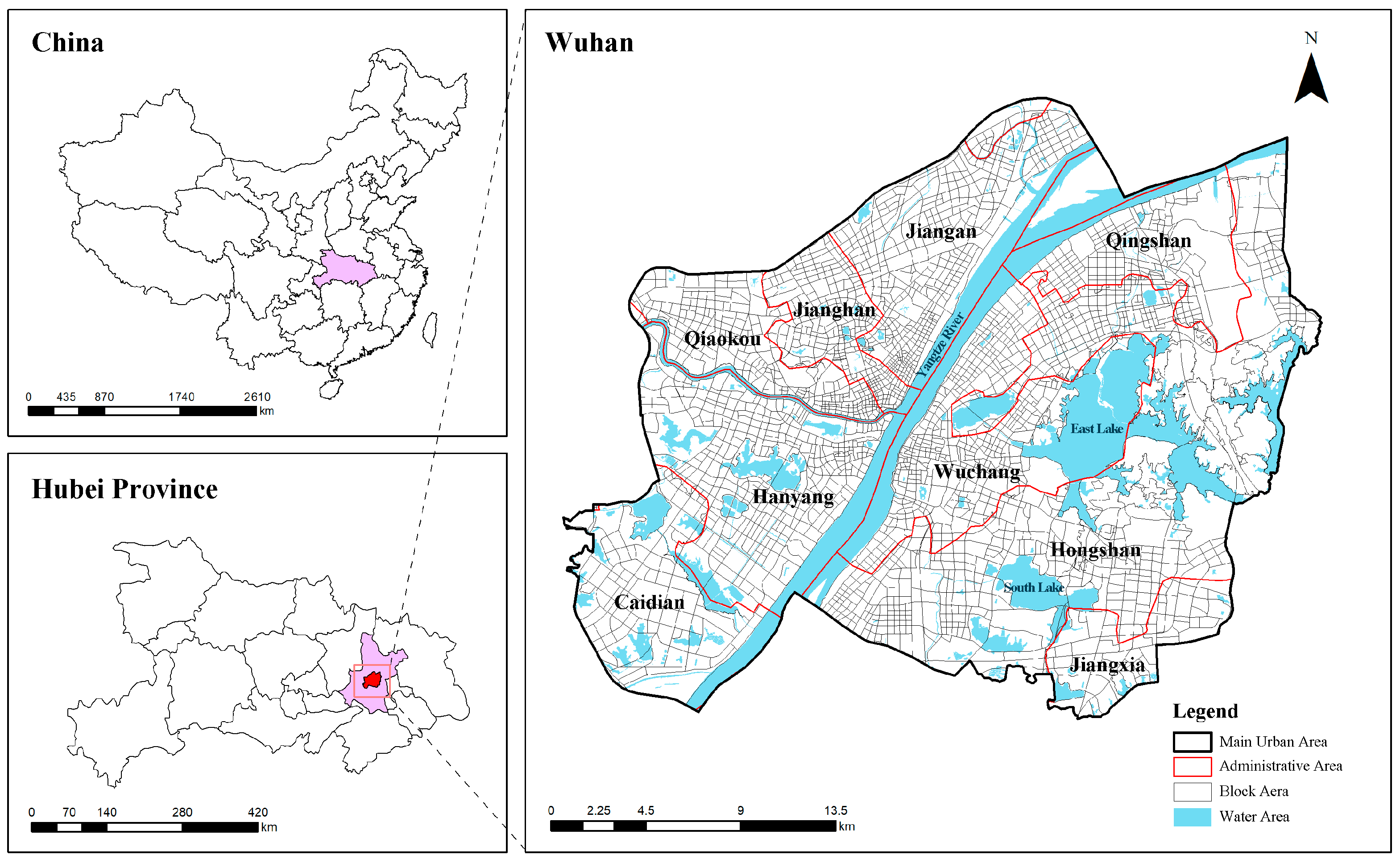
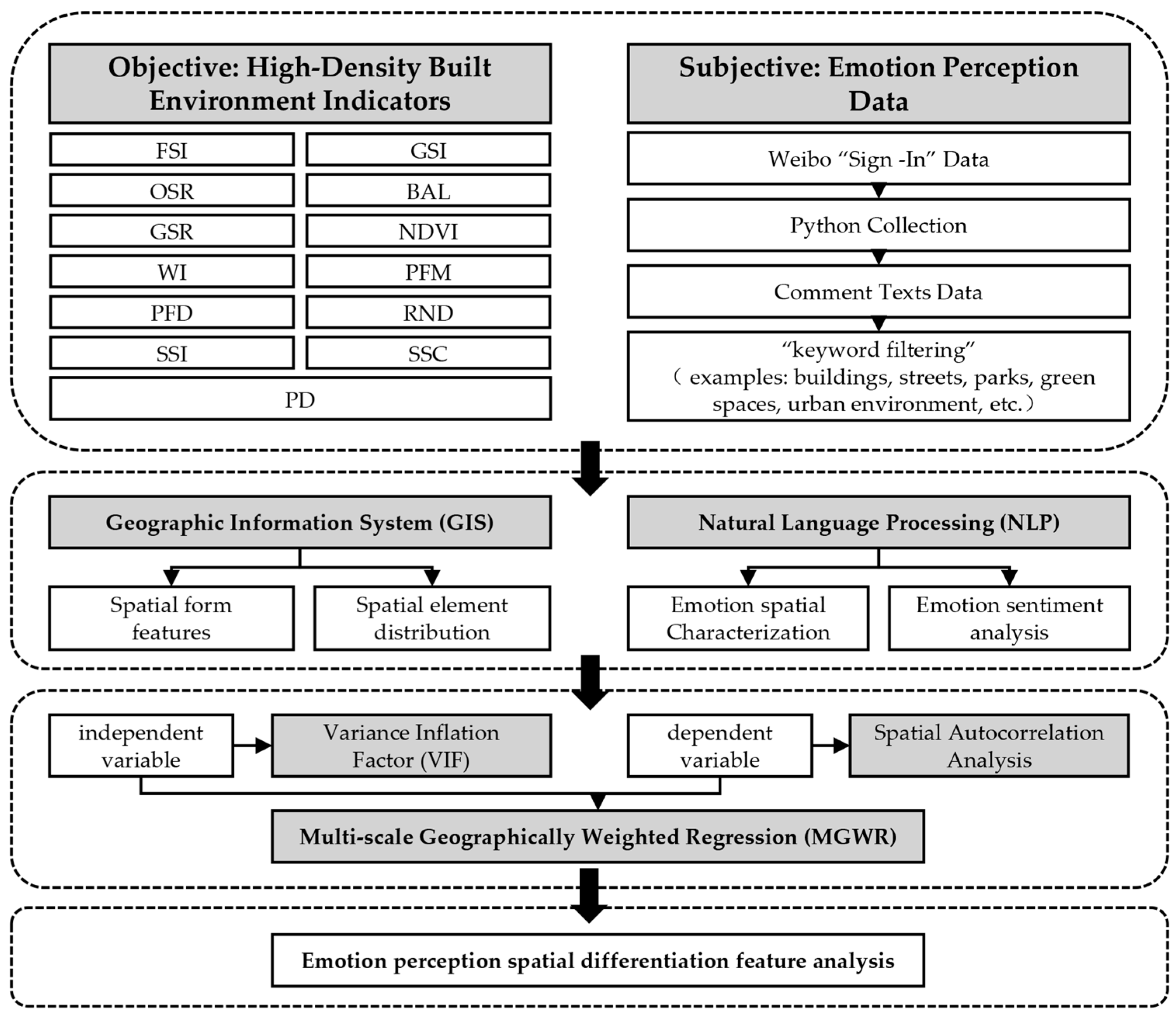

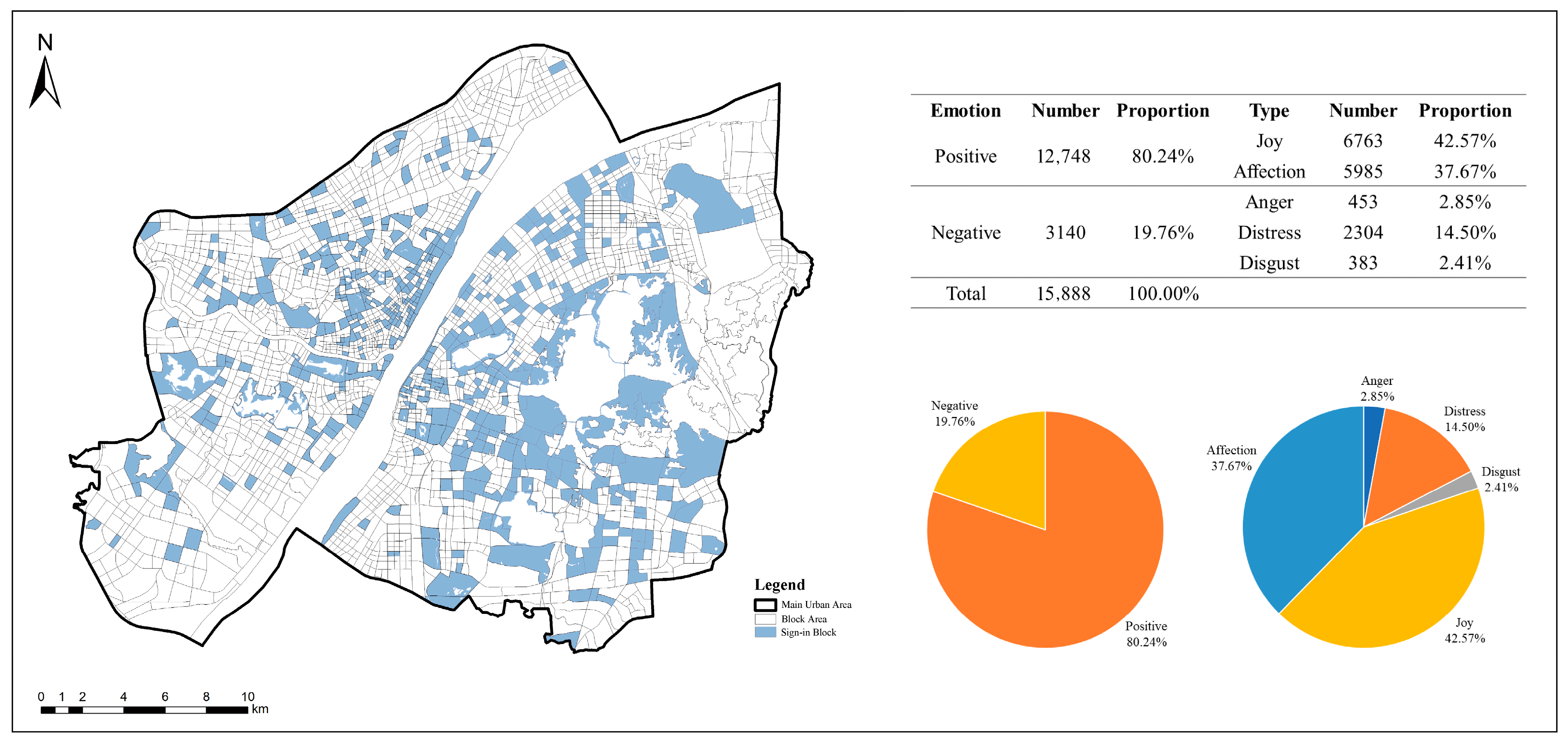
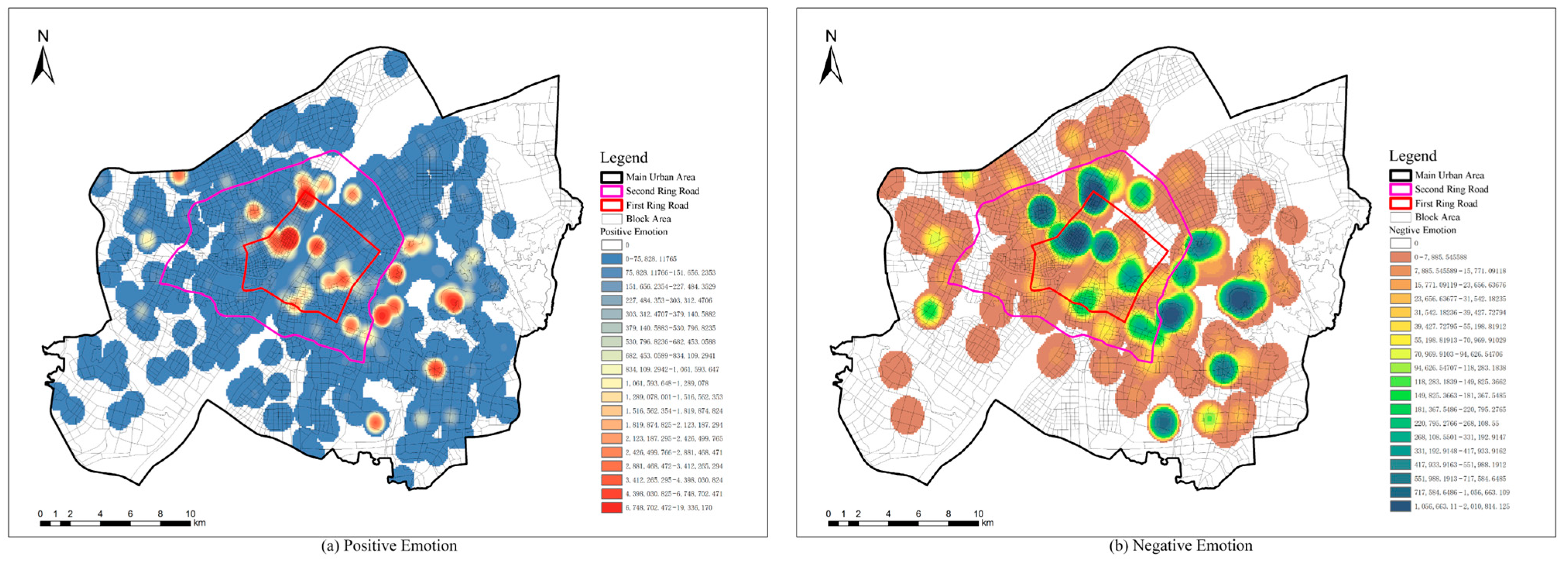
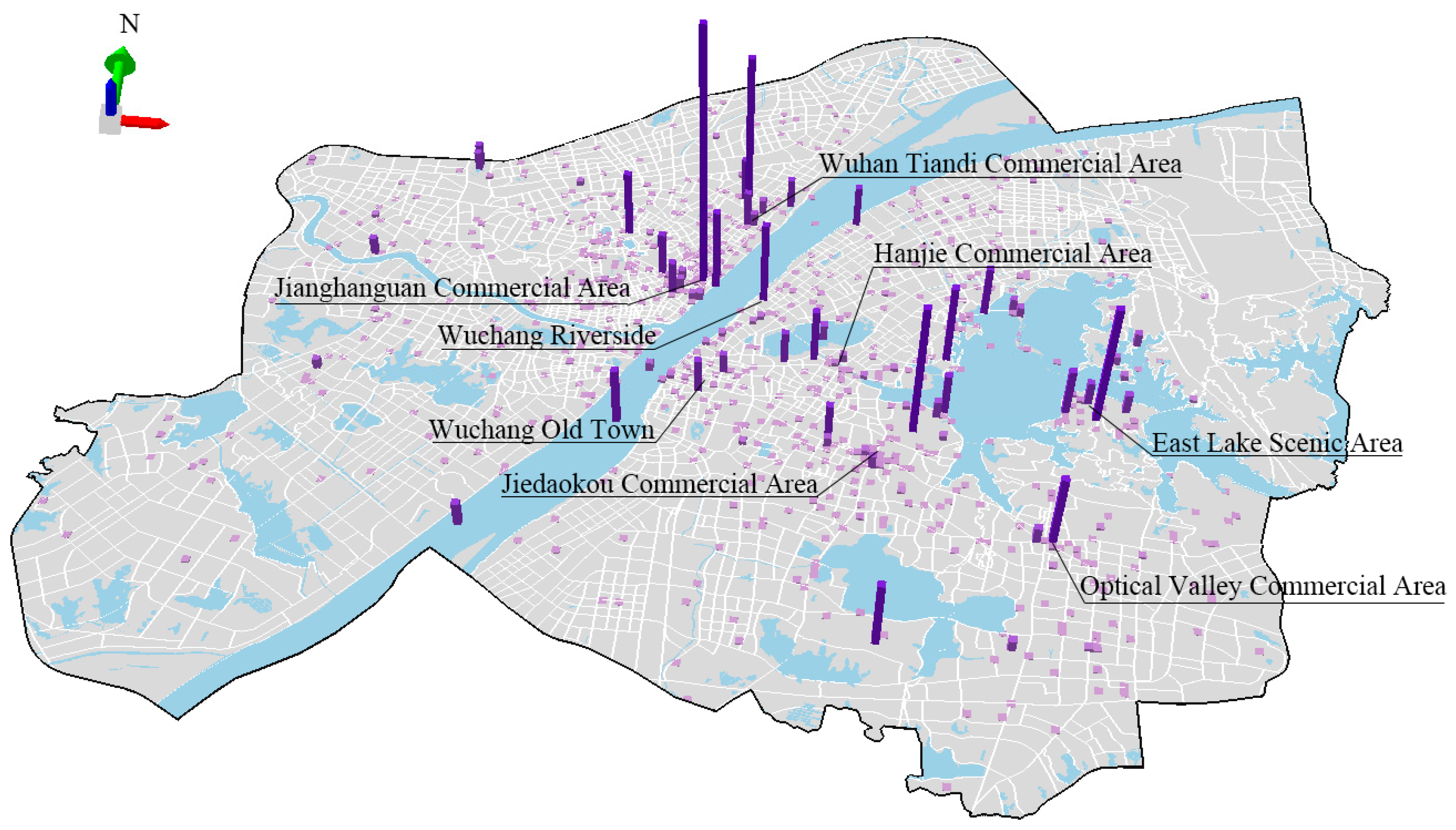

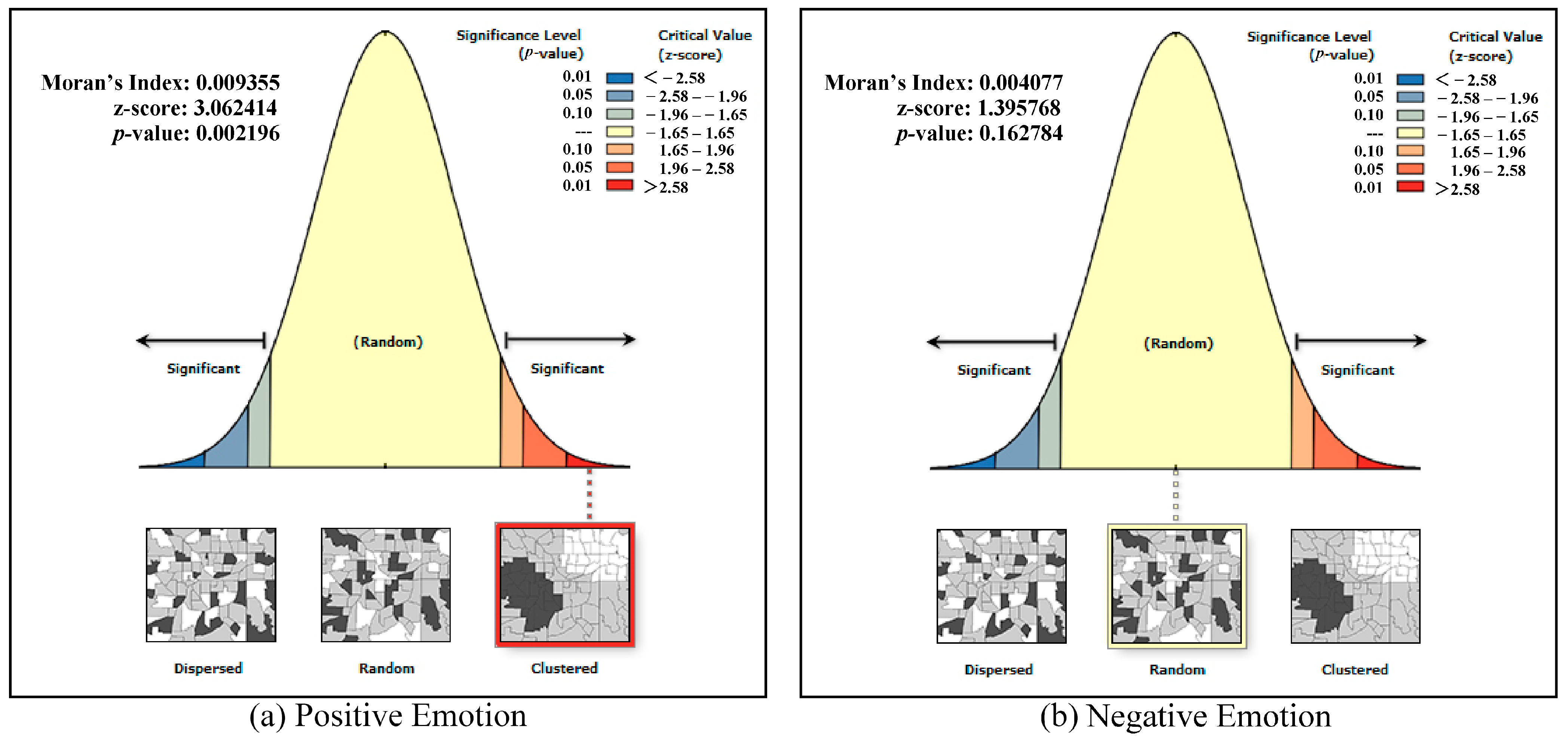
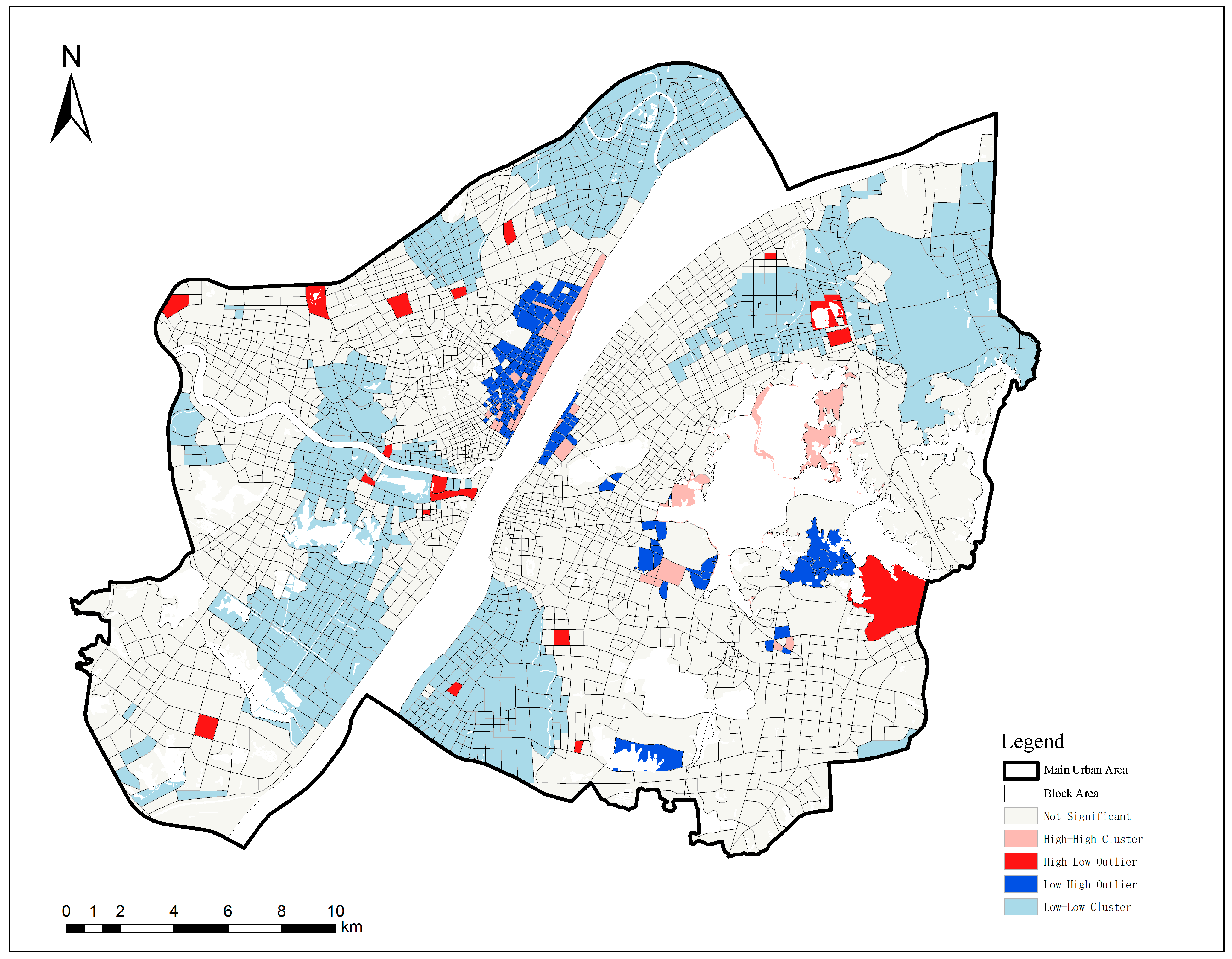
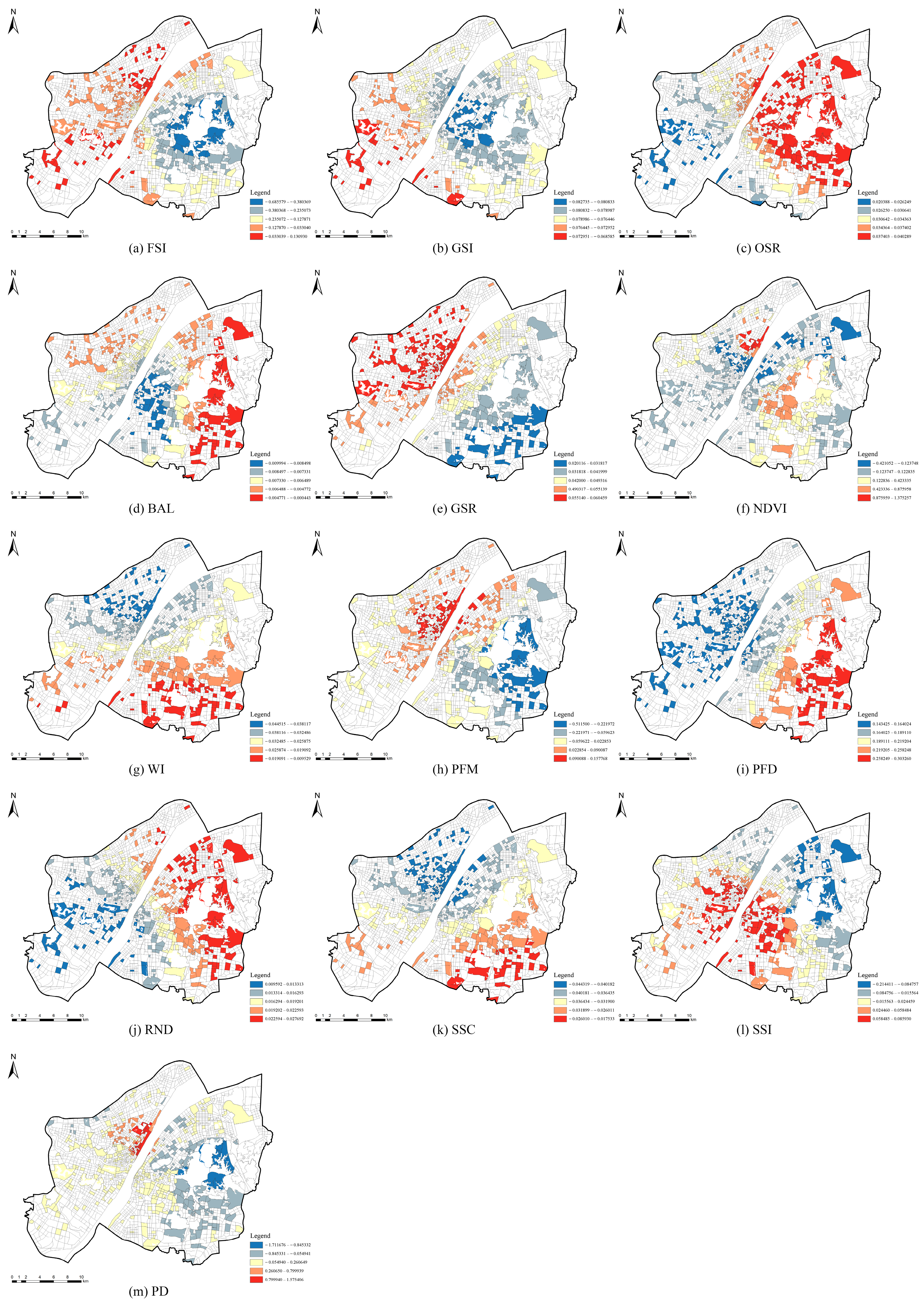
| Data | Access Time | Sources | Format |
|---|---|---|---|
| Block Area of Wuhan | - | Wuhan Geomatics Institute | .shp |
| Buildings of Wuhan | December 2022 | Open Street Map | .shp |
| Road Network of Wuhan | December 2022 | Open Street Map | .shp |
| POI in Wuhan | June 2023 | Baidu Map | .xlsx |
| Green Space of Wuhan | September 2023 | National Geomatics Center of China | .shp |
| Water Space of Wuhan | September 2023 | National Geomatics Center of China | .shp |
| NDVI of Wuhan | March 2023 | Resource and Environment Science and Data Center | .tif |
| Population of Wuhan | August 2022 | Wuhan Geomatics Institute | .csv |
| Emotion Type | Text Example | |
|---|---|---|
| Positive | Joy | I took a stroll in the Hankou Historical Block. On both sides of the street, were various Western-style buildings. What a surprising and romantic walk. |
| Affection | The skyline of Wuhan is spectacular. The city landmarks are visible at a glance, making it endlessly fascinating. | |
| Negative | Distress | Wuhan is huge, with tall and numerous buildings. There is always a strange sense of loneliness. |
| Disgust | There are so many traffic lights in Wuhan, and the city is congested every day. Everything feels chaotic, especially during rush hour, which can be suffocating. | |
| Anger | Why have so many vibrant communities been demolished? The old-fashioned local atmosphere is fading away, and high-density residential buildings feel like prisons. | |
| Variables | Coefficient [a] | Probability [b] | Robust_Pr [b] | VIF [c] |
|---|---|---|---|---|
| FSI | −8.645 | 0.165 | 0.154 | 3.553 |
| GSI | 7.139 | 0.890 | 0.757 | 3.724 |
| OSR | 29.286 | 0.456 | 0.156 | 2.682 |
| BAL | −1.080 | 0.395 | 0.175 | 2.006 |
| GSR | 3.736 | 0.513 | 0.479 | 1.227 |
| NDVI | 108.529 | 0.063 | 0.290 | 1.331 |
| WI | −0.008 | 0.308 | 0.057 | 1.135 |
| PFM | −7.565 | 0.029 | 0.060 | 2.286 |
| PFD | 7183.923 | 0.588 | 0.774 | 1.315 |
| RND | −0.256 | 0.997 | 0.997 | 1.299 |
| SSI | 0.296 | 0.620 | 0.512 | 1.025 |
| SSC | 10.021 | 0.433 | 0.687 | 1.564 |
| PD | 0.001 | 0.550 | 0.377 | 1.074 |
| Diagnostic Information | ||
|---|---|---|
| AIC | 1208.355 | |
| AICc | 1244.946 | |
| R2 | 0.504 | |
| Adj. R2 | 0.400 | |
| Bandwidths | FSI | 122 |
| GSI | 484 | |
| OSR | 484 | |
| BAL | 484 | |
| GSR | 484 | |
| NDVI | 52 | |
| WI | 482 | |
| PFM | 126 | |
| PFD | 409 | |
| RND | 484 | |
| SSI | 277 | |
| SSC | 484 | |
| PD | 44 | |
| Variables | Mean | STD | Min | Median | Max | p ≤ 0.005 Number of Significant Values |
| FSI | −0.149 | 0.132 | −0.686 | −0.118 | 0.131 | 95 |
| GSI | −0.079 | 0.003 | −0.083 | −0.079 | −0.028 | |
| OSR | 0.035 | 0.004 | 0.020 | 0.036 | −0.069 | |
| BAL | −0.007 | 0.002 | −0.010 | −0.007 | −0.000 | |
| GSR | 0.050 | 0.010 | 0.020 | 0.053 | 0.060 | |
| NDVI | 0.100 | 0.338 | −0.421 | −0.001 | 1.375 | 107 |
| WI | −0.030 | 0.008 | −0.045 | −0.033 | −0.010 | |
| PFM | 0.010 | 0.125 | −0.511 | 0.042 | 0.158 | 35 |
| PFD | 0.184 | 0.042 | 0.143 | 0.163 | 0.303 | 486 |
| RND | 0.018 | 0.004 | 0.010 | 0.017 | 0.028 | |
| SSI | 0.023 | 0.062 | −0.214 | 0.045 | 0.086 | 1 |
| SSC | −0.037 | 0.006 | −0.044 | −0.038 | −0.018 | |
| PD | 0.147 | 0.430 | −1.712 | 0.009 | 1.575 | 100 |
Disclaimer/Publisher’s Note: The statements, opinions and data contained in all publications are solely those of the individual author(s) and contributor(s) and not of MDPI and/or the editor(s). MDPI and/or the editor(s) disclaim responsibility for any injury to people or property resulting from any ideas, methods, instructions or products referred to in the content. |
© 2024 by the authors. Licensee MDPI, Basel, Switzerland. This article is an open access article distributed under the terms and conditions of the Creative Commons Attribution (CC BY) license (https://creativecommons.org/licenses/by/4.0/).
Share and Cite
Liu, W.; Li, D.; Meng, Y.; Guo, C. The Relationship between Emotional Perception and High-Density Built Environment Based on Social Media Data: Evidence from Spatial Analyses in Wuhan. Land 2024, 13, 294. https://doi.org/10.3390/land13030294
Liu W, Li D, Meng Y, Guo C. The Relationship between Emotional Perception and High-Density Built Environment Based on Social Media Data: Evidence from Spatial Analyses in Wuhan. Land. 2024; 13(3):294. https://doi.org/10.3390/land13030294
Chicago/Turabian StyleLiu, Wei, Dong Li, Yuan Meng, and Chuanmin Guo. 2024. "The Relationship between Emotional Perception and High-Density Built Environment Based on Social Media Data: Evidence from Spatial Analyses in Wuhan" Land 13, no. 3: 294. https://doi.org/10.3390/land13030294
APA StyleLiu, W., Li, D., Meng, Y., & Guo, C. (2024). The Relationship between Emotional Perception and High-Density Built Environment Based on Social Media Data: Evidence from Spatial Analyses in Wuhan. Land, 13(3), 294. https://doi.org/10.3390/land13030294






